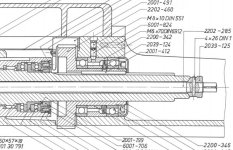ballen
Diamond
- Joined
- Sep 25, 2011
- Location
- Garbsen, Germany
I need to cut a 5/32" = 3.97mm key slot in a steel gear. I have a Deckel slotting head chisel, marked 4mm, which I had planned to use. But to my surprise it is 4.5mm wide, and also too wide in the other dimension. So I decided to make my own.
The chisel body is made from some steel stock, 20 x 20mm, which I milled down to 16 x 15.5mm. I turned down a portion of it to 12mm (probably should have picked 11mm, so it would fit nicely between the table slots).
To make the through-slot, I clamped the body at about 12 degrees in a vise (angle measured from some stock Deckel HSS chisels) and drilled 1.5mm holes in the 4 corners of a 4 x 16mm rectangle. Then I drilled out most of the material with a 3.7mm bit, and finished the slot with a 4mm end mill. Retainer is a 5mm grub screw.


The cutter itself comes from a strip of 4mm x 16mm HSS, sliced off with a abrasive wheel and then roughly ground to shape on a hand grinder. I've done a bit of relief on the outside, and plan to also grind a bit of relief on the sides. Hints welcome, I have not made a slotting cutter before.


Cheers,
Bruce
The chisel body is made from some steel stock, 20 x 20mm, which I milled down to 16 x 15.5mm. I turned down a portion of it to 12mm (probably should have picked 11mm, so it would fit nicely between the table slots).
To make the through-slot, I clamped the body at about 12 degrees in a vise (angle measured from some stock Deckel HSS chisels) and drilled 1.5mm holes in the 4 corners of a 4 x 16mm rectangle. Then I drilled out most of the material with a 3.7mm bit, and finished the slot with a 4mm end mill. Retainer is a 5mm grub screw.
The cutter itself comes from a strip of 4mm x 16mm HSS, sliced off with a abrasive wheel and then roughly ground to shape on a hand grinder. I've done a bit of relief on the outside, and plan to also grind a bit of relief on the sides. Hints welcome, I have not made a slotting cutter before.
Cheers,
Bruce








